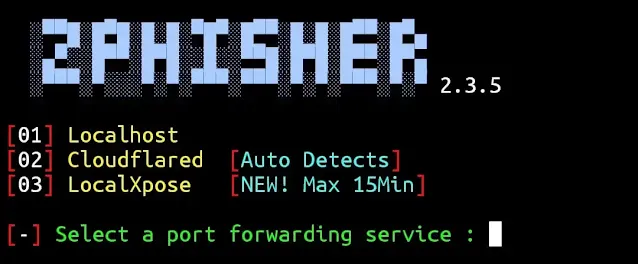Unmasking Zphisher
In the fast-changing world of online security, threats are becoming more complex. One persistent danger is phishing, a method used by cybercriminals to trick people into revealing sensitive information. This blog post takes a closer look at Zphisher, a tool that has gained attention for its role in phishing attacks.
What is Phishing?
- Phishing is a sneaky technique where cybercriminals deceive individuals into sharing sensitive details like usernames, passwords, and financial information.
- Phishing can take various forms, such as email phishing, SMS phishing, voice phishing, and website-based attacks.
Evolution:
- Phishing attacks have evolved over time, becoming harder to detect.
- Social engineering, manipulating people's minds, is a key factor in phishing.
How to Install zphisher - Click Here
Unveiling Zphisher:
Overview:
- Zphisher is an open-source tool that automates the creation and deployment of phishing pages.
- It makes it easy for cybercriminals to design convincing phishing campaigns, making it a serious threat.
Features:
- Template-based Phishing: Zphisher provides ready-made templates mimicking popular websites, making it simple for attackers to create convincing phishing pages.
- Credential Harvesting: The tool is made to collect login credentials, posing a significant risk to personal and business accounts.
- URL Spoofing: Zphisher helps attackers create URLs that look like real websites, increasing the chances of successful phishing attacks.
How Zphisher Works:
Installation:
- Zphisher is relatively easy to install, making it accessible to a broad audience.
- The tool works on various platforms and can be set up quickly for quick deployment of phishing campaigns.
Creating a Phishing Page:
- Users can choose a template from Zphisher or create a custom phishing page.
- The tool assists in making replicas of login pages, taking advantage of users' familiarity with legitimate websites.
Deployment and Distribution:
- Zphisher allows hosting phishing pages on various platforms, including GitHub.
- Attackers can share phishing links via emails, social media, or other channels to reach potential victims.
Protecting Against Zphisher:
User Awareness:
- Educating users to recognize phishing attempts is crucial.
- Teaching individuals to check URLs, verify secure connections (https://), and scrutinize email sender information can help reduce the impact of Zphisher attacks.
Advanced Email Filtering:
- Using advanced email filters can help identify and block phishing emails before reaching users.
- These filters use machine learning to analyze email content and detect suspicious patterns.
Two-Factor Authentication (2FA):
- Implementing 2FA adds an extra layer of security, requiring users to provide a second form of verification.
- Even if login details are compromised through phishing, an attacker would need the second factor to gain access.
Regular Software Updates:
- Keeping software and security systems up to date protects against vulnerabilities that tools like Zphisher could exploit.
- Regular updates include patches and fixes addressing known security issues.
Legal Implications:
Illegality of Phishing:
- Phishing is illegal in most places as it involves unauthorized access to sensitive information.
- Using Zphisher or similar tools for malicious purposes can lead to legal consequences, including fines and imprisonment.
Ethical Considerations:
- Ethical hackers and security researchers may use tools like Zphisher for educational purposes.
- However, using such tools with malicious intent violates ethical standards and can result in criminal charges.
Conclusion:
As the digital world evolves, the threat of phishing attacks, aided by tools like Zphisher, emphasizes the need for strong cybersecurity measures. Education, awareness, and advanced security technologies are vital for a proactive defense against phishing and other online threats. Staying informed and vigilant is key in the ongoing battle between cybersecurity professionals and cybercriminals.
















0 Comments